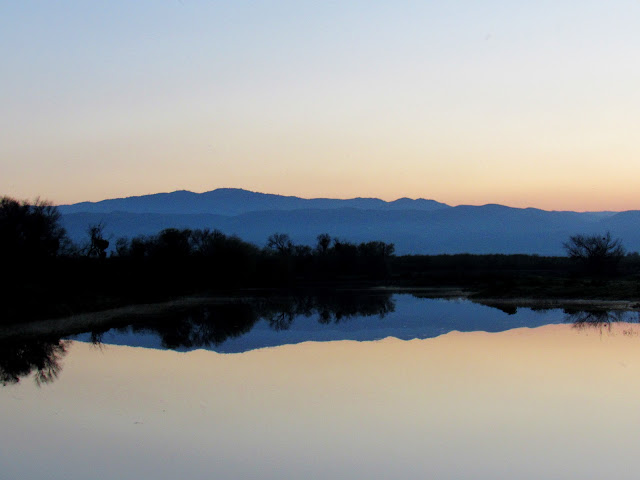In my
previous post about Elkhorn Slough, I outlined some of the major environmental services wetlands provide. I also mentioned their intrinsic value: the satisfaction of knowing these wild places exist and are protected, as well as the enjoyment that can be found in visiting such places. California's Great Central Valley is a beautiful and biologically rich place. Once a vast prairie crisscrossed by free-flowing rivers, this grassland was historically one of the most productive and diverse grasslands in North America.
 |
| Spring has arrived in the Great Valley! |
But the Great Valley was more than a grassland; it also supported a large system of seasonal freshwater marshes, fed by snowmelt from the Sierra Nevada. The largest concentration of these marshes lined Tulare Lake, in the southern San Joaquin Valley. As recently as 1900, Tulare Lake was the largest lake west of the Great Lakes. Surrounding the lake were vast stretches of seasonal wetlands that supported great biodiversity. Since 1900, rivers have been dammed, water diverted and wetlands drained. By the 1930's, Tulare Lake and its wetlands were gone.
This is the tale of about 94% of California's freshwater marshes; less than 6% of original marshland has been preserved, and even the remaining wetlands are extensively managed. But so far, migratory and over-wintering birds seem to have adapted to the new arrangement: fields are flooded in the winter to provide habitat for birds and other wildlife. Many species have declined, of course, as the Great Valley has been plowed and paved, but many are survivors, clinging to the last wild places. Some excellent examples of wild lands in California, especially wetlands, are found in our National Wildlife Refuges.
 |
| A cloudy spring day at Merced NWR |
I will urge you every chance I get to go out and visit one of our local National Wildlife Refuges. October through April are the best months for viewing wildlife, and offer visitors the most comfortable temperatures. Beyond May, the managed wetlands will be dry and the birds will have moved on along their natural migration routes. That being said, we have about a month left in the wetland season. Wildflowers are blooming, our summer songbirds that winter in the tropics are returning. Some ducks and winter birds are still hanging around. (Most of the
geese and
Sandhill Cranes have headed north already, but there might be a few stragglers.)
 |
| A Marsh Wren, singing at its nest. |
The wetlands are alive with birdsong: Marsh Wrens, Red-winged Blackbirds, Western Meadowlarks and Song Sparrows fill the air with song. Get out there and explore! You never know what you will see!
 |
| Yellow-headed Blackbirds - you can't miss them, with their bright coloring and noisy behavior! |
A few days ago, Eric and I found a large, noisy flock of probably 80 Yellow-headed Blackbirds (
Xanthocephalus xanthocephalus) at the Merced National Wildlife Refuge. A stunning sight!
 |
| Striking tropical-looking Yellow-headed Blackbirds |
Plus, we saw a few Lesser Scaups (
Aythya affinis), a handful of Buffleheads (Bucephala albeola) and a large flock of Ruddy Ducks (Oxyura jamaicensis). Northern Shovelers and Cinnamon Teals were plentiful, as were the lovely American Avocets (Recurvirostra americana).
 |
| Elegant American Avocet |
Trees bordering the wetlands offer nesting and roosting habitat for a number of songbirds as well as raptors. Look for American Kestrels (Falco sparverius), Red-tailed Hawks (Buteo jamaicensis), Swainson's Hawks (Buteo swainsoni), and Great Horned Owls (Bubo virginianus); Northern Harriers (Circus cyaneus) are often seen flying low over the wetlands.
 |
| You never know "hoo" might be watching you when you venture into the wetlands! |
If you're interested in mammals, the Merced and San Luis National Wildlife Refuges offer habitat for the endangered San Joaquin Kit Fox (Vulpes macrotis). More commonly seen are Desert Cottontails (Sylvilagus audubonii), Black-tailed Jackrabbits (Lepus californicus) and Coyotes (Canis latrans). The San Joaquin River NWR is home to North American River Otters (Lontra canadensis) and North American Beaver (Castor canadensis). And of course, let's not forget the impressive herd of Tule Elk (Cervus canadensis nannodes) at the San Luis NWR.
 |
| Black-tailed Jackrabbit, hoping to escape detection by blending into its surroundings. |
Take a little drive this spring and explore a wetland near you. To find your nearest National Wildlife Refuge, visit https://www.fws.gov/refuges/refugelocatormaps/california.html for a detailed map. But of course these aren't the only places you can go to revel in nature! Spend a morning along a river, hiking a trail, or even exploring your own property or neighborhood park. Small pieces of wilderness turn up everywhere when we take the time to look for them.
















Comments
Post a Comment